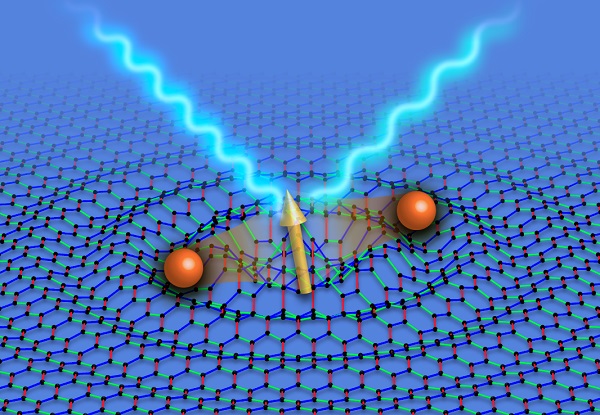Phantom Majorana particles found in insulating magnets Corroborative evidence of electron-spin fractionalization up to room temperature


An illustration of emergence of Majorana particles
Electron spins, which are the fundamental constituents in insulating magnets, are fractionalized by the scattering of light, resulting in the creation of two Majorana particles. This process leads to the characteristic temperature dependence of the intensity of the magnetic Raman scattering.
© 2016 Joji Nasu and Yukitoshi Motome.
University of Tokyo and Tokyo Institute of Technology researchers and their international collaborators have demonstrated by large-scale numerical simulations that phantom ‘Majorana particles’ emerge in an insulating magnet at a wide range of temperatures from extremely low up to room temperature.
Fundamental properties in magnets are governed by spins of electrons. So far, electron spins in conventional magnets have been understood to behave like bosons from their statistical nature. Bosons are a class of fundamental particle, and all particles in the universe are classified as either bosons or fermions. However, once an exotic quantum state called a ‘quantum spin liquid’ is realized in an insulating magnet, it was theoretically predicted that an emergent phenomenon called ‘fractionalization’ would take place, where the electron spins are fractionalized into several fermions, and the magnetic material would behave as fermions do. To prove this experimentally, the nature of this phenomenon has been studied at extremely low temperatures, but there are many disturbances other than electron spins. Thus, a completely different approach to this long-standing issue was strongly desired.
An international research group including Professor Yukitoshi Motome at the University of Tokyo Graduate School of Engineering carried out a large-scale numerical simulation for a theoretical model called the Kitaev model, which is known to exhibit quantum spin liquid behavior at absolute zero temperature (-273.15 Celsius), and studied the spectra for scattering of light. They found the emergence of phantom fermions, ‘Majorana particles’, in a wide temperature range. In addition, comparing these numerical results with US and Canadian experimental data obtained for a Ruthenium chloride, a magnetic insulator that is supposed to be well described by the Kitaev model, the group concluded that the emergent Majorana particles exist in this material in a wide temperature range from about -250 Celsius to room temperature. The result overturns conventional wisdom on magnetism, in which magnetic properties have long been discussed as governed by the physics covering boson behavior.
The present research makes a clear distinction from conventional research focusing only on the vicinity of absolute zero temperature. Majorana particles are a sort of phantom, which have long attracted attention in high-energy physics and recently become a target of interest in the field of quantum information. The present research will have a profound impact on these fields as it shows that insulating magnets provide a good playground to study the phantom Majorana particle.
“I couldn’t believe my eyes when I first looked at the plot in which our numerical results beautifully explain the experimental data,” says Motome. He continues “Magnetism is the only quantum phenomenon which we can observe with our own eyes and that can occur even at room temperature. I believe that the discovery of Majorana particles in magnets up to room temperature has a significant impact on not only the research of quantum magnetism but also other fields like quantum information.”
Paper
, "Fermionic response from fractionalization in an insulating two-dimensional magnet", Nature Physics Online Edition: 2016/07/05 (Japan time), doi: 10.1038/nphys3809.
Article link (Publication)
Links
Graduate School of Engineering
Department of Applied Physics, Graduate School of Engineering
Motome Group, Department of Applied Physics, Graduate School of Engineering






